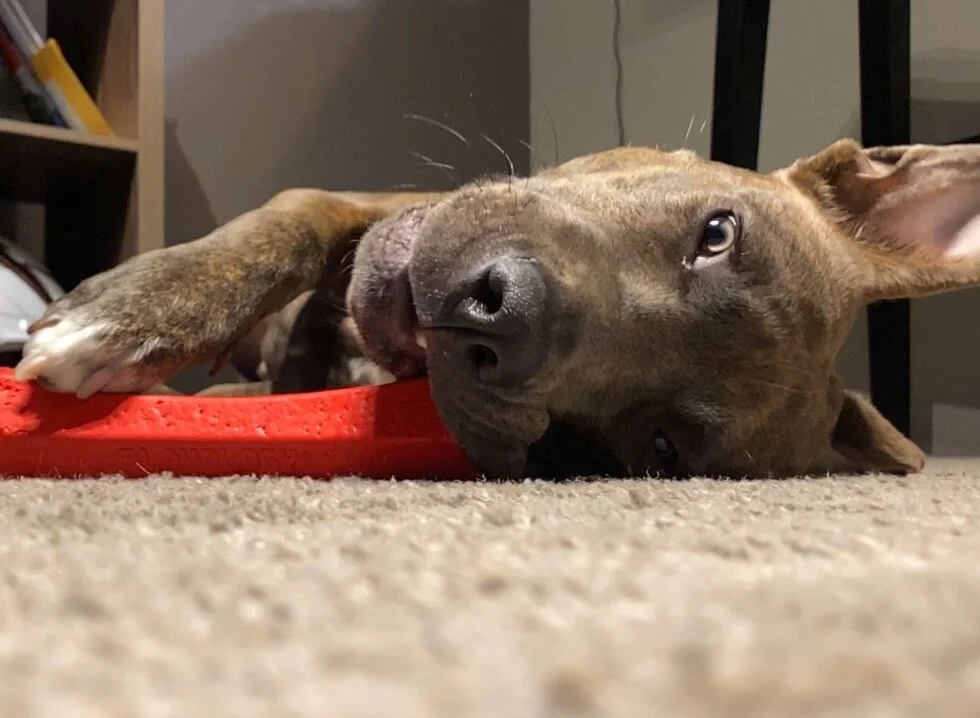Norman’s Training Journey
By Heather Leichner
Norman is a tough dog to train, but through multiple tactics and never giving up, owner Heather and her husband were able to help him make progress.
Norman in his new home.
My husband and I adopted our mix breed puppy from a shelter when he was six months old and weighed 45 pounds. We knew immediately that we would need a trainer. Even though Norman is the sweetest puppy, there were behavior issues apparent from the start. We hired our first trainer right away to help introduce Norman to our cat and make our home a safe environment for both of them.
“We hired our first trainer right away to help introduce Norman to our cat and make our home a safe environment for both of them.”
As the weeks went on and the training continued, Norman and the cat started to get along wonderfully. Norman had pretty much mastered the basic training commands, but his behavior worsened in other areas. We were taking him to the dog park almost every day because he was so hyper, but his interactions with the other dogs were not ideal. He seemed to play too hard and rough with other dogs. He didn’t understand when a dog no longer wanted to play so it led to a lot of frustration from both dogs.
We then decided to enroll Norman into a doggy daycare to help him learn how to interact properly with other dogs. That didn’t go well either. Norman went to daycare three times and, on the third day, a letter was sent home with him saying that he showed aggression towards a trainer and would possibly be removed from the program. At that moment, we decided to stop taking him to the dog park and stop bringing him to daycare. We hired another trainer to work on his behavior. This trainer said that Norman appears to struggle with impulse control and taught us ways to positively enforce calm behavior while on walks and through games that we could play at home.
“We hired another trainer to work on his behavior. This trainer said that Norman appears to struggle with impulse control and taught us ways to positively enforce calm behavior while on walks and through games that we could play at home.”
However, I began to notice that Norman had two very different sides to him. When we were with the trainer or on walks with my husband, Norman was well-behaved and tried his best to do what he was told. But when Norman and I would go for walks alone, it was a completely different story. He started randomly lunging at me, latching onto my arm, growling, and — at some points — biting me.
This problem behavior started at a tunnel near our apartment so I thought he was scared of the tunnel, so we just started avoiding it. Despite that, his behavior then started escalating to lunging and barking at passersby on bikes and skateboards. He was even jumping and biting at people holding the door open for us to our apartment building.
In the coming weeks, it got to the point where I was afraid to walk Norman alone, and he even started acting this way towards me when we would go outside for a simple potty break. With the seriousness of these behavioral issues and the fact that they were getting worse, we started looking for a stricter method of training.
“With the seriousness of these behavioral issues and the fact that they were getting worse, we started looking for a stricter method of training.”
We considered signing him up for a board and train program, but instead reached out to our daycare and asked for suggestions. They referred us to our third trainer whose method revolved more around leadership than positive reinforcement. She saw Norman’s issue as him not viewing me as “the boss,” but instead viewing me as a playmate… so whenever I tried to get him to listen to me or make him stop chasing after a person on a bike, he would get frustrated and come after me.
After a one-hour training session, and properly and safely incorporating a prong-collar, Norman was a completely different dog. He no longer comes towards me with any frustration or aggression. He walks right beside me, and we rarely have to enforce with the prong-collar. He continues to struggle with bikers, but not to the same level of aggression, and we intend to slowly introduce him to the concept of biking in the coming months.
“All of this progress happened within three months of bringing Norman home! Without training and working hard to find the proper training solutions that work for both us and our dog, I can guarantee that we would not have been able to keep Norman. But with all the hard work we have put into him, I am positive he is going to turn out to be an amazing and well-behaved dog.”
All of this progress happened within three months of bringing Norman home! Without training and working hard to find the proper training solutions that work for both us and our dog, I can guarantee that we would not have been able to keep Norman. But with all the hard work we have put into him, I am positive he is going to turn out to be an amazing and well-behaved dog.
Keep up the training and never give up!
*This story is one dog owner’s experience. If your dog has issues with aggression, please seek out professional help from a trainer!
Norman’s Bell
When we adopted our Norman from a shelter, it was very clear that he was not with his dog family for very long and had not been properly socialized. The first signs of this were that he didn’t know how act appropriately around other dogs and he didn’t know how to make “proper” dog sounds. He wouldn’t whine when he needed to go potty or wanted to be let out of his crate. Since we live in an apartment, he had some issues communicating to us when he needed to go outside.
So, after doing some research, we decided to get Norman a bell and teach him to ring it when he has to go potty. At the beginning, we would place the bell on the ground and force him to ring the bell by picking up his paw and doing it ourselves. After a week or so of doing this, we started luring him with a treat to ring the bell on his own before we would take him out to go potty.
Now, about three weeks into the training, he rings the bell when told to before a potty break, or when he REALLY has to go — but is not quite fully consistent with it yet. However, we believe in a few more weeks, this will be a great solution for his lack of communication skills, and can even be translated for different skills such as wanting food or wanting to go on a walk!




